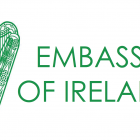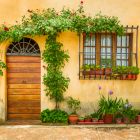Golf goes back to Roman times.
According to the Encyclopaedia Britannica, the earliest form of golf is attributed to the Romans. Over 2,000 years ago, as Rome expanded its borders as far north as Britannia, invading armies carried with them a home-grown game called paganica, practised with a stick and a stitched leather ball stuffed with feathers. The idea of hitting a ball as far as possible towards a defined target seemed to catch on. Through the centuries, games similar to paganica developed in England, France, Italy, the Netherlands and China. Modern golf developed in Scotland where the feathery ball, identical to that used for paganica, was standard for several centuries. It was replaced only in the mid-19th century when the first rubber ball the guttie was introduced.
Somewhere along the way, Italians appear to have lost some enthusiasm for paganica derivatives. There are roughly 80,000 Italian registered golf players, a low figure compared with,for example, England, where the number is closer to a million. Italian golfers are obliged to acquire the Italian Golf Federation tessera or licence, which may be obtained only by first joining a golf club, making the game an expensive business. Direct licensing along the lines of the successful breakaway from the German Golf Federation launched some years ago is unlikely to occur anytime soon in Italy.
The 8,500 plus golfers in Lazio have a choice of 25 facilities that include championship courses, nine-hole courses, driving ranges and even a pitch and putt course. Most clubs are busy with sponsored competitions on weekends and holidays but are relatively free during weekdays.
The following courses are private but most are happy to receive visiting golfers who pay green fees during the week.
Acquasanta Roma in Via Appia Nuova is Italys oldest golf club, established in 1903. Some distance away from Acquasanta but still in Via Appia Nuova lies Circolo del Golf Fiornanello. Further south is Castelgandolfo Country Club an 18-hole course laid out within an extinct volcanic crater.
In the province of Latina in Via Nettunense is Eucalyptus Golf Club (directly accessible from Campo di Carne station on the regional train line Roma-Nettuno) and about ten kilometres from there is Nettuno Golf Club.
Two city courses within Romes ring road, the Gran raccordo anulare (GRA), are Parco de Medici near Fiumicino motorway and Parco di Roma in Via dei Due Ponti just off Via Flaminia. A little further along Via Flaminia and just outside the GRA is Golf Club Arco di Costantino.
Going north on the Via Cassia is one of Romes most well-known and exclusive clubs, Olgiata, situated within the residential area of the same name in Via Cassia. Le Querce is just short of Viterbo (still driving north of Rome). Both offer superb championship courses and have hosted the Golf World Cup in past years.
To the east of Rome in Via Nomentana near Guidonia lies SS Golf Club Marco Simone territory of Italian designer Laura Biagiotti, who is president of the club.
In Italy, public courses are a rarity and the one at Fiuggi to the south of Rome, established in 1928, is the nearest you can get to the pay-and-play principle. As with those listed above, most other clubs will accept visiting golfers who pay green fees, particularly during the week when the course is less busy. Visiting golfers are advised to telephone beforehand to book tee times and also to receive clear directions to the club, which may be difficult to find.
Some clubs are strict about dress code so it would be wise to avoid wearing jeans, T-shirts or trainers and perhaps bring a jacket and tie if dining. Golf shoes with soft spikes are obligatory in many clubs. Bring your handicap certificate (should you have one) or equivalent with you as you may be asked for some form of proof that you are a serious golfer before being allowed onto the course.
Club membership can be expensive because established protocol requires the purchase of an initial share in the club and the payment of an annual fee. Clubs like Olgiata, Castelgandolfo and Acquasanta are an example.
Some clubs, however, offer simplified membership packages for newcomers to the game and members of the diplomatic corps for example. These vary but generally consist of everything open to a normal member, but for a limited period of time. Diplomats are charged roughly 2,000 a year for membership at Acquasanta. As they are not permanent members, no share need be acquired.
Therefore it is a good idea to shop around. Joining an association such as Diplomatic and International Golfers Association (DIGA) is a good option.
Clubs with nine-hole courses such as Marediroma at Torvaianica have a more informal atmosphere and driving ranges such as Tevere Golf on the banks of the Tiber near Ponte Milvio offer membership at very reasonable rates both a good choice for beginners.
Weekday green fees vary from roughly 15 for nine holes up to 80 for 18 holes. Prices are higher at weekends. Motorised carts, also known as golf buggies, cost 25-?40, registration for club competitions from 15 and professional golf instructors for lessons (available at all facilities) 30-40 per half-hour. Driving range green fees cost from 5.
Prices quoted are approximate.
Note that most clubs have a closing day during the week.
For information and addresses see www.wantedinrome.com/resources
or visit www.federgolf.it.





















